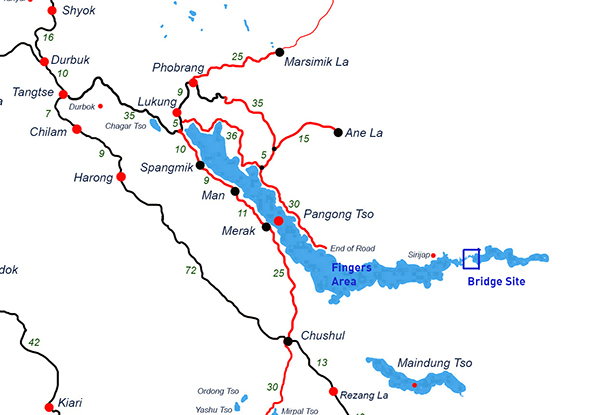Continuing with infrastructure build-up on its side of the area near the Line of Actual Control (LAC) in eastern Ladakh, China is building a new bridge on Pangong Tso which will provide an additional axis to deploy troops faster between the north and south banks of the lake, and closer to the LAC.
Sources said the bridge is being constructed more than 20 km east of Finger 8 on the lake’s north bank – India says Finger 8 denotes the LAC. The bridge site is just east of Khurnak Fort in Rutog county where the PLA has frontier bases. There is a frontier defence company at Khurnak Fort, and a water squadron further east at Banmozhang.
Since the military standoff began in May 2020, India and China have not only worked to improve existing infrastructure, but have also built several new roads, bridges, landing strips along the entire frontier.
Pangong Tso, an endorheic lake, is 135 km long, of which more than two-thirds is under Chinese control. Khurnak Fort, close to where China is building the new bridge, is near the halfway mark of the boomerang-shaped lake.
Historically a part of India, Khurnak Fort has been under Chinese control since 1958. From Khurnak Fort, the LAC is considerably west, with India claiming it at Finger 8 and China claiming it at Finger 4.
The north and south banks of the lake were among the several friction points that surfaced after the start of the standoff. Before India and China pulled back troops from the north and south banks in February 2021, the area had seen massive mobilisation and the two sides even deployed tanks, barely a few hundred metres apart in some locations.
Towards the end of August 2020, India outmanoeuvred China to capture the previously unoccupied heights of the Kailash Range on the south bank of the lake.
Indian troops positioned themselves on the peaks there, including Magar Hill, Gurung Hill, Rezang La, Rechin La, and this allowed them to dominate the strategic Spanggur Gap — it can be used for launching an offensive, as China had done in 1962 — and also gave them a view of the PLA garrison at Moldo.
Indian troops had also positioned themselves above the Chinese troops in the Fingers area on the north bank. During this scramble for the heights, shots had been fired by both sides, a first in over four decades.
Troops from the two countries remained on these heights through the harsh winter months. The significance of these positions was one of the main factors that compelled China to negotiate a pullback.
Both countries agreed to a pullback from the north bank of the lake, and positions on the Kailash Range in the Chushul sub-sector south of Pangong Tso.
Sources said that the new bridge built by China will allow it to mobilise its troops faster in this area, hoping to prevent a repeat of what happened in August 2020.
China has been developing infrastructure in the entire region since the start of the standoff — it is still to be resolved. The widening of roads, building of new roads and bridges, new bases, airstrips, advance landing bases, etc are not restricted to the eastern Ladakh region, but are happening across the three sectors of the India-China boundary.
India too has been improving its infrastructure in the border areas. Last year, the Border Roads Organisation completed more than 100 projects in border areas, the majority of which were close to the border with China. India is also improving its surveillance along the entire 3488-km boundary, and has been building new airstrips and landing areas.


















